高中英语 模块二第一单元reading部分完整说课稿 牛津版
模块2Unit1Reading教案(译林牛津版高一英语必修二教案教学设计)
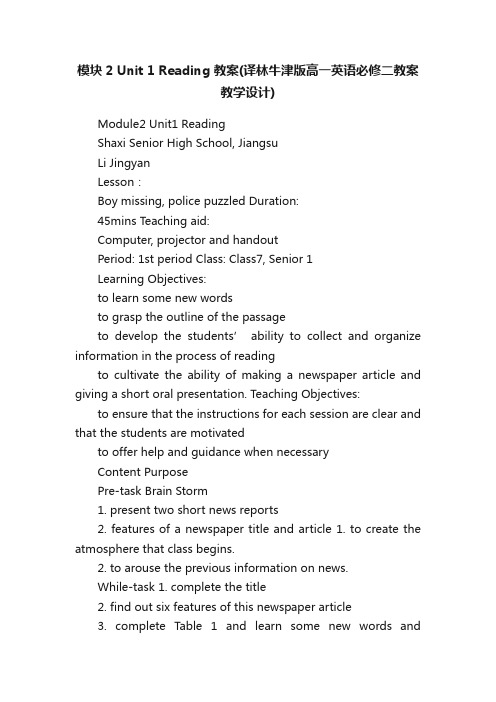
模块2 Unit 1 Reading 教案(译林牛津版高一英语必修二教案教学设计)Module2 Unit1 ReadingShaxi Senior High School, JiangsuLi JingyanLesson:Boy missing, police puzzled Duration:45mins Teaching aid:Computer, projector and handoutPeriod: 1st period Class: Class7, Senior 1Learning Objectives:to learn some new wordsto grasp the outline of the passageto develop the students’ ability to collect and organize information in the process of readingto cultivate the ability of making a newspaper article and giving a short oral presentation. Teaching Objectives: to ensure that the instructions for each session are clear and that the students are motivatedto offer help and guidance when necessaryContent PurposePre-task Brain Storm1. present two short news reports2. features of a newspaper title and article 1. to create the atmosphere that class begins.2. to arouse the previous information on news.While-task 1. complete the title2. find out six features of this newspaper article3. complete Table 1 and learn some new words andexpressions4. magic cube-to face the challenge in the cube (choose one word and answer the questions, then get proper points) 1. to know the title’s features2. to develop the skimming and scanning abilities.3. to help Ss draw the outline of the whole text and enlarge vocabulary and enhance the ability of guessing when they meet with some new words in reading4. to cultivate their ability of facing a challenge and develop their practical abilityPost-task 1. team work: write an ending report to the news1. to cultivate the team spirit and Ss’ imagination and practical ability.Assignment 1. read the text several times and finish C1 andD on page42. write a short news report. 1. to consolidate the understanding of the text2. to put theories into practice教学说明:本节课为新授第一课时,是导入及课文内容理解部分。
牛津高中英语模块二Unit1 Reading完整ppt课件
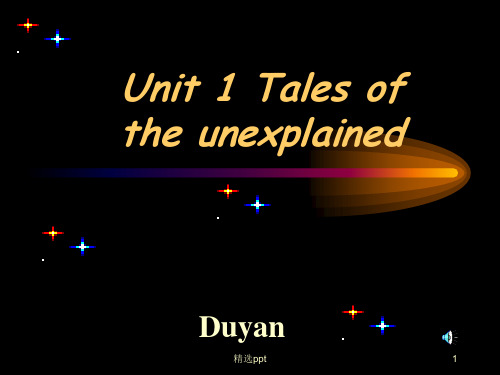
missing. Justin Foster__d_i_d__n_o_t_s_h_o_w___u_p_
_a_t__t_h_e_f_a_m__il_y__lu_n__ch__t_h_e_n__e_x_t_d_a_y_The police Justin’s friends said ___J_u_s_t_in
found that
_w_e_n_t__h_o_m__e_a_f_t_e_r__t_h_e__g_a_me. Witnesses said ___t_h_e__y_s_a_w
_J_u_s_t_in__w_a__lk_i_n_g_t_o_w__a_r_d_s_h_ is
Justin _h_o_m_e__a_t__1_0_.4_5__p_._m_._._____
精选ppt
7
Reading strategy(策略)
?How do we read a news story? Title and the pictures The first paragraph
the main topic and most important facts
The paragraphs followed detailed(详细的) information and background information(背景知识)
精选ppt
15
1.We should read the title and the pictures first to get some information about it.
2.The 1st paragraph gives the details about the most general information(the general idea) and the important facts.
牛津译林版英语必修二Unit1Reading1教案
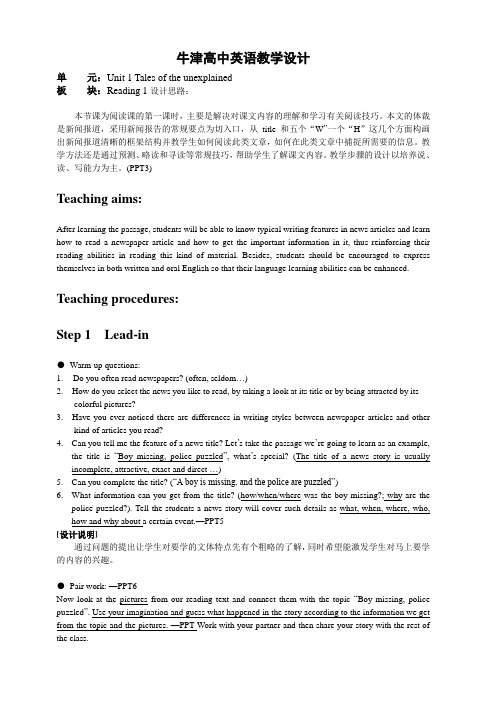
牛津高中英语教学设计单元:Unit 1 Tales of the unexplained板块:Reading 1设计思路:本节课为阅读课的第一课时,主要是解决对课文内容的理解和学习有关阅读技巧。
本文的体裁是新闻报道,采用新闻报告的常规要点为切入口,从title和五个“W”一个“H”这几个方面构画出新闻报道清晰的框架结构并教学生如何阅读此类文章,如何在此类文章中捕捉所需要的信息。
教学方法还是通过预测、略读和寻读等常规技巧,帮助学生了解课文内容。
教学步骤的设计以培养说、读、写能力为主。
(PPT3)Teaching aims:After learning the passage, students will be able to know typical writing features in news articles and learn how to read a newspaper article and how to get the important information in it, thus reinforcing their reading abilities in reading this kind of material. Besides, students should be encouraged to express themselves in both written and oral English so that their language learning abilities can be enhanced.Teaching procedures:Step 1 Lead-in●Warm-up questions:1.Do you often read newspapers? (often, seldom…)2. How do you select the news you like to read, by taking a look at its title or by being attracted by itscolorful pictures?3. Have you ever noticed there are differences in writing styles between newspaper articles and otherkind of articles you read?4.Can you tell me the feature of a news title? Let’s take the passage we’re going to learn as an example,the title is “Boy missing, police puzzled”, what’s special? (The title of a news story is usually incomplete, attractive, exact and direct …)5.Can you complete the title? (“A boy is missing, and the police are puzzled”)6.What information can you get from the title? (how/when/where was the boy missing?; why are thepolice puzzled?). Tell the students a news story will cover such details as what, when, where, who, how and why about a certain event.—PPT5[设计说明]通过问题的提出让学生对要学的文体特点先有个粗略的了解,同时希望能激发学生对马上要学的内容的兴趣。
牛津高中英语全英文说课稿-Reading部分.
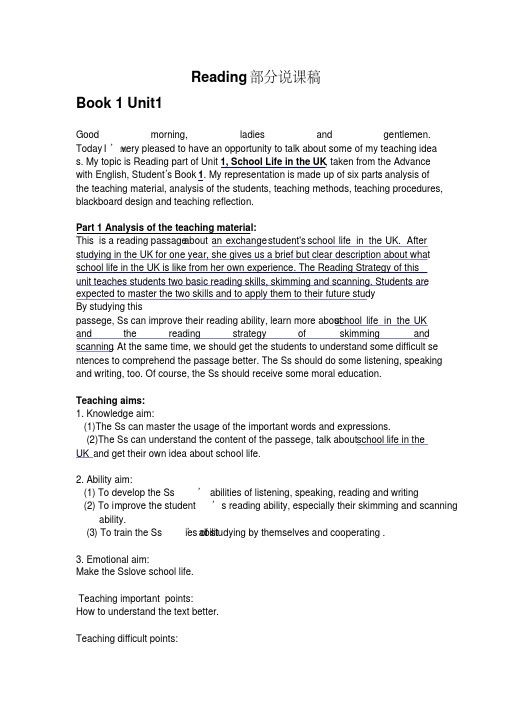
Reading部分说课稿Book 1 Unit1Good morning, ladies and gentlemen. Today I’mvery pleased to have an opportunity to talk about some of my teaching ideas. My topic is Reading part of Unit 1, School Life in the UK, taken from the Advancewith English, Student’s Book 1. My representation is made up of six parts:analysis ofthe teaching material, analysis of the students, teaching methods, teaching procedures, blackboard design and teaching reflection.Part 1 Analysis of the teaching material:This is a reading passage about an exchange student's school life in the UK. After studying in the UK for one year, she gives us a brief but clear description about what school life in the UK is like from her own experience. The Reading Strategy of thisunit teaches students two basic reading skills, skimming and scanning. Students are expected to master the two skills and to apply them to their future study.By studying thisschool life in the UK passege, Ss can improve their reading ability, learn more aboutand the reading strategy of skimming and scanning. At the same time, we should get the students to understand some difficult se ntences to comprehend the passage better. The Ss should do some listening, speaking and writing, too. Of course, the Ss should receive some moral education.Teaching aims:1. Knowledge aim:(1)The Ss can master the usage of the important words and expressions.(2)The Ss can understand the content of the passege, talk about s chool life in theUK and get their own idea about school life.2. Ability aim:(1) To develop the Ss’ abilities of listening, speaking, reading and writing(2) To improve the student’s reading ability, especially their skimming and scanningability.ies of studying by themselves and cooperating .(3) To train the Ss’ abilit3. Emotional aim:Make the Ss l ove school life.Teaching important points:How to understand the text better.Teaching difficult points:1. Use your own words to retell the text.2. Discuss t he school life in different countries.Part 2 Analysis of the students:1. The Ss have known something about the school life in different countries through the Internet and other ways.2. They are lack of vocabulary.often use English to express themselves and communicate with others.3. They don’t4. Some Ss are not active in the class because they are afraid of making mistakes.Part 3 My teaching theories, methods and aidsBefore dealing with this lesson, I’ll do my best to carry out the following theories: Ma; Combin ke the Ss the real masters in class while the teacher himself acts as directore the language structures with the language functions; Let the students receive some moral education while they are learning the English language.Teaching method:Question-and-answer activity teaching methodWatch-and-listen activityFree discussion methodPair work or individual work methodTask-approach teaching methodTeaching aids:1. a projector2. a tape recorder3. multimedia4. the blackboardPart 4 Teaching proceduresI have designed the following steps to train their ability of listening, speaking, reading and writing, especially reading ability.The entire steps are: Revision, Lead-in, Fast reading(skimming andscanning), Listening, Intensive reading, Preparation for details of the text, Consolida tion, Discussion, HomeworkStep 1 Lead-in:1.1 Show some pictures and movies about school life in the UK1.2 Ask students to present the information they have collected before1.3 Ask them to discuss the differences and to try to think of the reasons.interest of study.Purpose: Arouse the students’Step 2 Fast reading(skimming and scanning)Ask students to go through the article as quickly as possible and to try to finish Part A and CInform them to only focus on and identify the information needed.Purpose: Improve the s tudents’fast reading ability.Step 3 ListeningPlay the tape recorder and ask them to finish Part C,Purpose: Train the Ss’ listening ability and prepare for later exercises.Step 4 Intensive readingRead the passage carefully again and answer some detailed questions on the screen.A. What specific aspects are mentioned in the text? (teachers, classmates, friends, subjects, homework/assignments, grades, timetable, activities, school facilities, host family, food, hobbies, customs, traditions,festivals)B. Diagram(on the blackboard)On the first dayTeachers Mr HeywoodMiss BurkeSize of a classroomSubjectsFoodIt is also called depth reading or study reading. It means reading for detailed informati on.Purpose: Further understand the text (Train further reading ability) to find out some different sentences and details of the text.Step 5 Preparation for details of the text on the screenHave students be familiar with some language points(blackboard) in the text and then give them some examples sentences.A. experience(line 2): countable nounB. attend(6)C. way(9)D. earn(10)E. sound(11): linking verb F. as...as (20)G. for free(29) H. miss(42): verb Purpose: Train the Ss’ ability of understanding and using laguage.Step 6 Reading Strategy on P3Tell them that skimming is to look at the titles and headlines, the first and last sentences of paragraphs and the first and last paragraphs as well as pictures and charts to get a general idea of what a text is about. And scanning is to focus on keywordsand phrases, dates, numbers, etc. to find certain information in a text quickly.Step 7 Consolidation1. Find out the topic sentences.2. Retell the passage according to the topic sentences.Purpose: I want to know if my students understand the whole text really and if they m aster what I mean to tell them in this class. What’smore, I want to let them have the a bility of introducing and analyzing expression. At the same time, I will write down thetopic sentences on the blackboard according to what the students find, so they can ret ell it easily.Step 8 Discussion/PracticeAsk students do an activity: Interview Wei HuaPurpose: help students improve their imagination.Step 9 HomeworkWrite an acticle about the differences of school life betwween UK and China.Part 5 blackboard designReading: School life in the UKDiagram:On the first dayTeachers Mr HeywoodMiss BurkeSize of a classroomSubjectsFoodWei Hua’s feeling and progressLanguage Points:A. experience(line 2): countable nounB. attend(6)C. way(9)D. earn(10)E. sound(11): linking verb F. as...as (20)G. for free(29) H. miss(42): verb。
模块2 unit1 reading language points(译林牛津版高一英语必修二教案教学
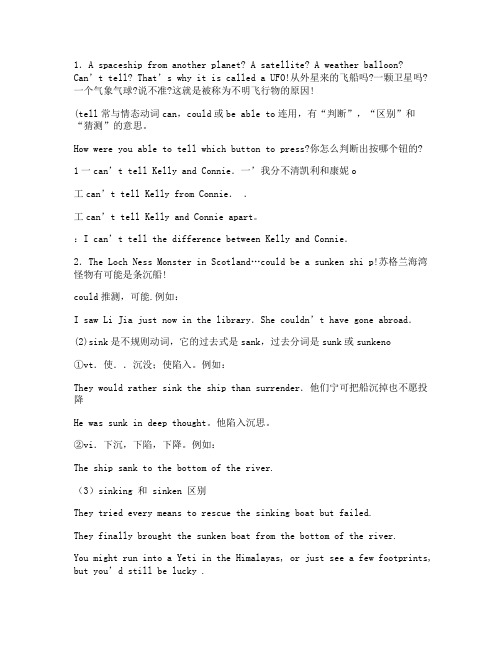
1.A spaceship from another planet? A satellite? A weather balloon? Can’t tell? That’s why it is called a UFO!从外星来的飞船吗?一颗卫星吗?一个气象气球?说不准?这就是被称为不明飞行物的原因!(tell常与情态动词can,could或be able to连用,有“判断”,“区别”和“猜测”的意思。
How were you able to tell which button to press?你怎么判断出按哪个钮的?1一can’t tell Kelly and Connie.一’我分不清凯利和康妮o工can’t tell Kelly from Connie..工can’t tell Kelly and Connie apart。
:I can’t tell the difference between Kelly and Connie.2.The Loch Ness Monster in Scotland…could be a sunken shi p!苏格兰海湾怪物有可能是条沉船!could推测,可能.例如:I saw Li Jia just now in the library.She couldn’t have gone abroad.(2)sink是不规则动词,它的过去式是sank,过去分词是sunk或sunkeno①vt.使..沉没;使陷入。
例如:They would rather sink the ship than surrender.他们宁可把船沉掉也不愿投降He was sunk in deep thought。
他陷入沉思。
②vi.下沉,下陷,下降。
例如:The ship sank to the bottom of the river.(3)sinking 和 sinken 区别They tried every means to rescue the sinking boat but failed.They finally brought the sunken boat from the bottom of the river.You might run into a Yeti in the Himalayas, or just see a few footprints, but you’d still be lucky .你也许在喜马拉雅山会遇到雪人或但看到几个脚印,但你仍然是幸运的,.L2”“”run into①撞进,使撞人。
高中英语 模块2U1.reading课件 牛津版必修2
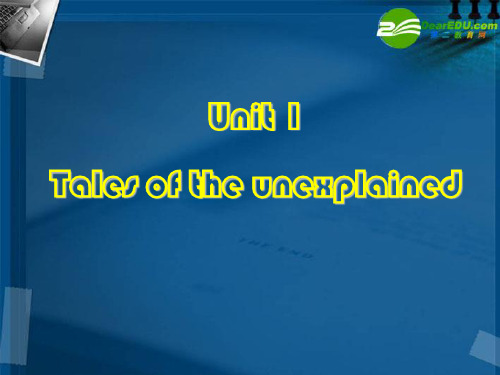
Mavis Wood said _________________
_________________________________
Questions:
Which city does Justin Foster live in?
He lives in Dover, New Hampshire.
What did Justin do with friends last Friday?
He went to play baseball with two friends. What time did Justin get back home that night? At about 11 p.m. What does Kelly think happened to her brother? She thinks the aliens took her brother.
Read the text quickly and do the below questions!
1. What is the article about ?
2. When was Justin last seen?
3. Who is in charge of the case?
Read in detail:
Give an ending to the story.
Suppose you are a reporter from China Daily. You are making a faceto-face interview with a person who has just come back from one of the mysterious places below.
牛津译林版英语必修二Unit1Reading1教案
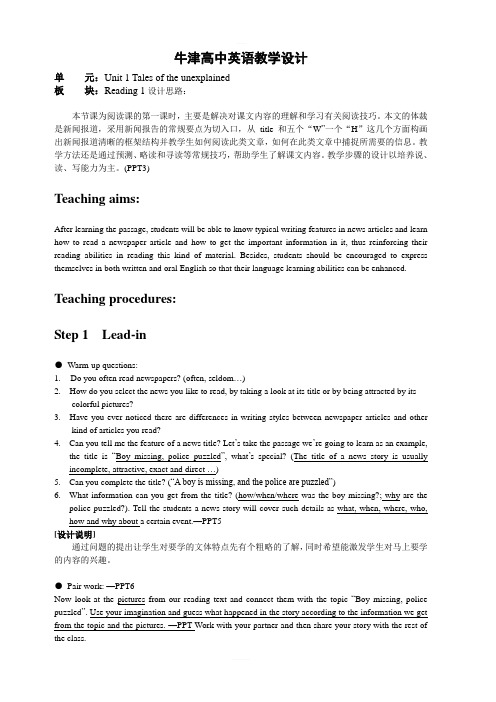
牛津高中英语教学设计单元:Unit 1 Tales of the unexplained板块:Reading 1设计思路:本节课为阅读课的第一课时,主要是解决对课文内容的理解和学习有关阅读技巧。
本文的体裁是新闻报道,采用新闻报告的常规要点为切入口,从title和五个“W”一个“H”这几个方面构画出新闻报道清晰的框架结构并教学生如何阅读此类文章,如何在此类文章中捕捉所需要的信息。
教学方法还是通过预测、略读和寻读等常规技巧,帮助学生了解课文内容。
教学步骤的设计以培养说、读、写能力为主。
(PPT3)Teaching aims:After learning the passage, students will be able to know typical writing features in news articles and learn how to read a newspaper article and how to get the important information in it, thus reinforcing their reading abilities in reading this kind of material. Besides, students should be encouraged to express themselves in both written and oral English so that their language learning abilities can be enhanced.Teaching procedures:Step 1 Lead-in●Warm-up questions:1.Do you often read newspapers? (often, seldom…)2. How do you select the news you like to read, by taking a look at its title or by being attracted by itscolorful pictures?3. Have you ever noticed there are differences in writing styles between newspaper articles and otherkind of articles you read?4.Can you tell me the feature of a news title? Let’s take the passage we’re going to learn as an example,the title is “Boy missing, police puzzled”, what’s special? (The title of a news story is usually incomplete, attractive, exact and direct …)5.Can you complete the title? (“A boy is missing, and the police are puzzled”)6.What information can you get from the title? (how/when/where was the boy missing?; why are thepolice puzzled?). Tell the students a news story will cover such details as what, when, where, who, how and why about a certain event.—PPT5[设计说明]通过问题的提出让学生对要学的文体特点先有个粗略的了解,同时希望能激发学生对马上要学的内容的兴趣。
牛津高一英语模块2Unit1单元完整教案
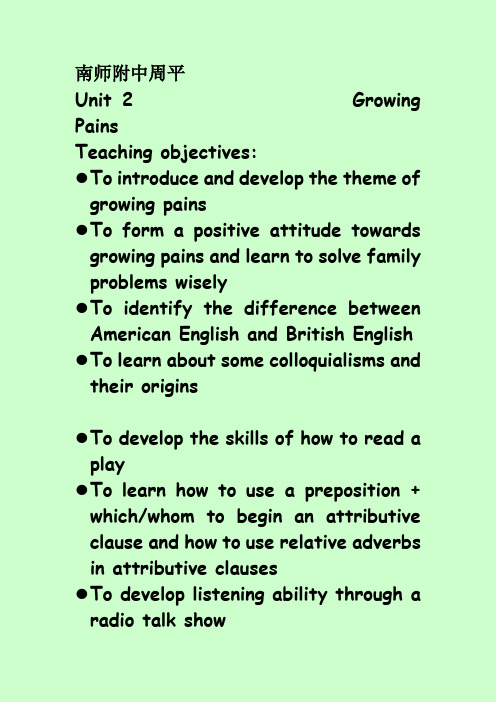
南师附中周平Unit 2 Growing PainsTeaching objectives:●T o introduce and develop the theme of growing pains●T o form a positive attitude towards growing pains and learn to solve family problems wisely●T o identify the difference between American English and British English ●T o learn about some colloquialisms and their origins●T o develop the skills of how to read a play●T o learn how to use a preposition + which/whom to begin an attributive clause and how to use relative adverbs in attributive clauses●T o develop listening ability through a radio talk show●T o develop speaking ability by talking about problems common to teenagers and presenting a dialogue based on the relevant theme●T o develop the ability of reading for gist●T o develop writing ability by presenting a dialogue and an advice letter●T o learn to be cooperative and helpful when working together●Teaching plans:Period 1—Welcome to this unit Period 2—Reading 1 (Comprehension focus)Period 3—Reading 2 (Word focus) Period 4—Reading 3 (Consolidation of words)Period 5—Word power1Period 6—Word power2Period 7—Grammar & usagePeriod 8—Consolidation of grammar Period 9—Task presenting a dialogue1 Period 10—Task presenting a dialogue2 Period 11—Project writing an advice letterPeriod 12—ExercisesPeriod 1 Welcome to this unitTeaching objectives:●T o introduce and develop the theme of growing pains●T o develop speaking ability by talking about families and problems that happen between teenagers and parents●T o know more about classmates andtheir familiesTeaching procedures:I.Lead-in:1.Presenting family albums:In this part, Ss are encouraged to say something about their families by showing the class pictures with their parents.2.Brainstorming questions:●D o you always show respect to your parents?●D o you always do what your parents want you to?●D o you sometimes quarrel with your parents? Why do you quarrel?II.Picture talking (pair work)●A sk Ss to look at the pictures. Imagine the situations and try to describe them as fully as possible withtheir own words.●M ake sure that Ss have “when”, “where”, “who”, “what”in your descriptions.●I nvite some Ss to report back their descriptions.III.Sharing opinions (group work)In this part, Ss discuss the following questions in groups of four. Each group chooses two of the four questions. Have Ss to report their opinions in class. Questions for discussion:●W hat kind of behaviors of yours will make your parents feel unhappy? List as many as you can.*not doing homework,*not getting up on time,*spending too much time or money on …*bad school behaviours*not helpful with housework*making friends with persons that parents don’t like*…●W hat would you do if your behavior upsets your parents?●W ho do you choose to talk to when you have a problem and want to talk to someone? Why?●D o you think there is a generation gap between you and your parents? How do you overcome the gap?IV.Assignments:1.Preview the new words of thisunit on page 64 (from “act” to“rude”)2.Think about thisquestions—What are growingpains? Do you have any pains?What are they?*********************************** ********************Period 2 Reading 1(Comprehension focus)Teaching objectives:●T o develop the skills of how to read a play●T o know about American family life and problems that happen between American teenagers and their parents ●T o form a positive attitude towards solving problems between teenagers and parentsTeaching procedures:I.Lead-in:●H ave you ever been left alone or witha pet? Describe that experience. If not, can you imagine what might happen if you were left alone? Can you look after your home and keep everything clean and safe?II.Reading:1.Remind Ss of the instructions onreading a play before reading2.First reading and checking outPart A on page 223.Second reading (following thetape) and checking out C1 & C2 on page 244.More comprehension questions:●W hy does Eric sound frightened when he sees his parents back?●H ow does Mom know that the dog istired and hungry?●W hat does Dad mean by saying “This is not a family where bad behavior goes unpunished…”?III.Thinking after reading:Ask Ss to use their imagination and think of an end to the play.●D o you think Eric and Daniel will explain to their parents what has happened? Or will the parents go and ask the boys what has happened?●I f you were one of the children what would you do? Would you remain silent or would you offer an explanation to your parents? Which is the better solution in your mind?IV.Assignment:1.Read the play aloud withpartners.2.Underline difficult words orsentences that need explaining.3.Finish D1 & D2 on page 24.4.Finish E on page 25.*********************************** *******************Period 3 Reading 2(Word Focus) Teaching objectives:T o understand new words and expressions and learn how to use them Teaching procedures:I.HW checking out:1.D1 & D2 on page 242. E on page 25Ask Ss:●w hat they think of the way Daniel and his parents solve their problem●w hat kind of a boy Daniel isII.Difficult points:(In this part, Ss are encouraged to raise their questions.)1.Eric runs in after it, followed bya big dog, walking very slowly.2.…you weren’t supposed to comehome until tomorrow!3.Daniel, we thought you were anadult, …4.Eric sits on his bed looking atDaniel, who has his arms cross edand looks angry.5.…but now that he has been so rudeto us, I feel like we have to punishhim or he won’t respect us.III.Words focus:1.Word definition:In this part Ss are to understand words and expressions in the text.Ask Ss to match the expressions in Column I with the right definitions in Column II.Column IColumn IIa. be supposed to do 1. to talk aboutsb’s faults in an unfair way,or to be toostrict with sb.b. deserve to do 2. to want tohave sth. or do sth.c. now that 3. used to ask ortalk about how sb. shoulddeal with sth.d. in charge 4. used to say a light or fire is off or oute. be hard on 5. used to saywhat is/was expectedto happen,esp. when sth. didn’t happen; used to saythat one should or should not dof. go out 6.to hope that one will get sth. from sb.g. expect…from…7.in a position where you have the duty to makedecisions so that anything bad will not happenh. feel ed to sayone should receive (areward ora special treatment) for what he has donei. (what to) do with9. because ofsth. or as a result of sth.2. Ask Ss to read the following sentences and try to complete them with words or expressions in the text so that each of the sentences makes sense.1.The new company was set up lastmonth and has some problems anddifficulties, so we can say thecompany is experiencing ________.(growing pains)2 ---Doctor, my son feels pains in hisarms and legs at night. What’swrong?---It really doesn’t matter. That’s________ and will soon pass.(growing pains)3. His strange question made hisfriends feel surprised; thatmeans his strange question______ his friends. (surprised)surprise—n./ vt.surprised—adj.surprising—adj.surprisingly—adv.●M y dad bought me an iPod on my birthday, which is a great ____ to me. (surprise)●W hat _____ me most was that flowers there were so cheap. (surprised)●H e had a _____ look on his face at the news that she married John. (surprised)●---How was the exam?---_____ easy. (surprisingly)5.The sports meet _________ totake place last weekend. But we had to cancel it because it was raining heavily. (was supposed)6.Wang Bing had his hair dyed and his red hair upset his parents. They say as a student he should not dye his hair, that is, he _________ dye his hair. (is not supposed to)6. The morning assembly takes place on the playground at 7:30 on every Monday. So teachers and students _______ be there by 7:25. (are supposed to)7.Mrs. Smith is a mother of three and knows a lot about looking after babies. You can ask her what to ______ a newborn baby if you have no idea. (do with)8.Little Tim did a good job at school and he hoped that his parents would praise him. He ____ a praise _____ his parents. (expect…from)9. The mother never praises herdaughter unless she gets the firstin test. She is too strict with him,that is, she is ______ him.(hard on)10.Daniel thought his parents _______ him because they shouted at him before he could explain. (hard on)11. The Chinese Women’s Volleyballteam won the championship in the28th Olympic Games. They workedvery hard and they _____ win.(deserved to)12. That boy spends little time onlessons and seldom listens in class.He failed in the exams. He _____fail. (deserved to)13. ---It is so hot. I _____ a bigiced cola. What about you?---Mineral water, please.(feel like)IV. Assignments:1.Finish A1 & A2 on page 86.2.Finish D1 on page 89.Make sure Ss read the text carefully and review what they’ve learned before doing exx.****************************************************Period 4 Reading 3(Consolidation of words)Teaching objectives:●T o consolidate the use of words and expressions throughTeaching procedures:I. Checking out A1 & A2 on page 86: II.Checking out D1 on page 89: III.Assignments:1.Memorize the new words in thetext and get ready for a dictationtomorrow.3. Read the play again and think about the question:●I s the play written in British English or American English? How do youknow?********************************* ********************Period 5 Word Power 1 Teaching objectives:●T o identify the difference between American English and British English ●T o develop the ability of understanding words in context Teaching procedures:I.Lead-in: Dictation of words in thetext:(Ask a student to write on the blackboard.)vacationsoccertrash cangarbageliving roombehavioradultdecisionexplaindeserveII.Word Power1.focusing on the differencesbetween American English & British English by checking out the dictation on the blackboard:American English B ritish Englishvacation holidaysoccer footballtrash can dustbingarbage rubbishliving room sitting roombehavior behaviour*Ask Ss “In which aspects doesAmerican English differ fromBritish English from the examplesabove?”(in vocabulary and spelling)* Ask Ss “Does American Englishdiffer from British English in otheraspects, like pronunciation andgrammar? Encourage them todemonstrate some examples. Differences Examples pronunciationgrammarspellingvocabulary* Ask Ss to use the information onpage 26 and practice the dialogueon page 26.* Ask Ss to discuss the following questions:T he accents in American English andBritish English are partly different. Which do you prefer?●D o you think it helpful to know about these differences?2.Understanding words in context: * Letting Ss read “A” on page 90 sothat they can learn more about thistopic.* Checking out the comprehension questions* Understanding some new words from the context of the passage●H e was the major reason for the program’s huge success. major—very large or important●M ike kept making trouble but was always charming. charming—very pleasing or attractive●F rom the first few episodes of “Growing Pains”Mike was always getting into trouble. episode—part of a TV or radio program in which the same story is continued●T hese stories are good examples of the two sides of Mike’s nature. nature—qualities that make someone a particular type of person●H e was naughty but also a caring and warm person.naughty—(used by adults talking about children) bad, causing trouble caring—thinking about what other people need or want and trying tohelp themIII.Assignments:1.For bonus: Find two moreexamples showing the difference between American English and British English and tell your teacher as soon as possible. The first one will get a BONUS.2.Do “B” on page 91.*******************************************************Period 6 Word Power 2(Colloquialisms focus)Teaching objectives:T o learn about some colloquialisms and their originsTeaching procedures:I. HW checking out:1. Collecting examples of American English and British English2. Checking out “B” on page 90II. Colloquialisms1.What is a colloquialism? How is itused?2.Presenting sentences withcolloquialisms:I know you are busy, but could you just lend me an ear for a minute? Meaning: to listen and pay attention toOrigin: In William Shakespeare’s time, around 1600, it was a common way of asking that you listen to a personspeaking. Shakespeare used this expression in his play “Julius Caesar”.●I f we don’t win this basketball game by at least twenty points, I will eat my hat.Meaning: a saying used when you are 100 percent certain that something will happenOrigin: Many great writers, including Charles Dickens, have this expression.3.Ask Ss to focus on Part A and havethem finish this exercise individually.Origins of some colloquialisms:●a wet blanketmeaning: a person who spoils other people’s fun by being boring origin: This is an early 19th-century expression. Native Americans and others often put out their campfires with blankets they had dipped in the nearest river. If fire represents excitement and joy, then the wet blanket that puts out the fire stands for a person who always expects bad things will happen.a ll earsmeaning: eager to listen; listening attentivelyorigin: This expression is three centuries old. The ear is the organ by which a person hears. So, if we say you are all ears, it means that at that moment you’re carefully listening towhatever is being said. It is as if no other organs of your body mattered except your ears.p ull my legmeaning: to fool someone; to joke with someoneorigin: By the late 1800s people sometimes tripped other people by catching their legs with a cane or running a string across the sidewalk. Sometimes it was just for fun; at other times robbers did it to steal from the victim after he or she had fallen.4.Ask Ss to do Part B on page 27.In this part, Ss are encouraged to discuss with each other first. Ask them to use dictionaries if necessary.III. Assignments:1.Work out the meanings of thefollowing colloquialisms:a.My parents and I don’t always seeeye to eye about school issues.b.I’ve got a major test tomorrow, soI better hit the books.c.Lisa was walking on eggs when shewas returning the necklace shehad borrowed without asking. 2.Review the attributive clause learntin Unit 1.3.Read the play again and pick outsentences containing attributive clauses.Period 7 Grammar andUsageTeaching objectives:* To learn how to use a preposition + which/whom to begin an attributive clause and how to use relative adverbs in attributive clausesTeaching procedures:I.HW checking out: understandingsome colloquialismsII. Grammar and Usage:1.Let Ss read Point 1-4 on page28 to know when to use apreposition + which/whom to beginan attributive clause. Teachergives detailed explanations ifnecessary.2.Ask Ss to do “A” & “B”on page29.3.Let Ss read Point 5 on page 28to know how to use the attributiveclause to modify the antecedentway.4.More practice should beprovided to Ss.●T he pen with which I write my homework every day is broken, so I’llhave to buy a new one.●C an you please give me a piece of paper on which I can write a note toMiss Liu?●D o you know the woman with whom/to whom/about whom our teacher is talking?●T he man from whom/for whom I bought the old picture is over eighty.●T he way (in which/that)she sang surprised all the judges.* * * *●D o you still remember the day on which we first met each other?●Y esterday we visited a factory in which toys are made.●S he didn’t tell us the reason for which she gave up her job.5.relative adverbs: when, whereand why●D o you still remember the day on which/when we first met each other?●Y esterday we visited a factory in which/where toys are made.●S he didn’t tell us the reason for which/why she gave up her job.6.let Ss read instructions on page307.practice on page 31III. Assignments:1. Do C1 on page 88 (WB)***************************** *********************Period 8 Consolidation of grammarTeaching objectives:T o have more practice on the usage of attributive clausesTeaching procedures:I.Consolidation of Grammar:1.HW checking out—C12.Additional practice—this partfocuses on situations in which relative pronounces and relative adverbs are usedTell Ss that when, where or why can’t be used to introduce an attributive clause if the antecedent is used as the subject or object in the clause thoughthey refer to a time or a place or a reason.Examples are as follows:●S hanghai is the first city that Eric visited in China.●The city that/which gives Eric a deep impression in China is Shanghai.●S hanghai is the city where Eric’s grandfather used to work.●H e will always remember the days that/which he spent in America.●H e will always remember the days when he studied in America.●N o one knows the reason why he changed his mind.T he reason that/which he gave us is not good enough.3.Do C2 on page 88.Ask Ss to do this exercise individually and check out in class.II.Assignments:1.Read the diary entries on page 34and underline the main point of each entry and circle the words which tell you the mood of the writer. (Make sure Ss read the guidelines on page34 before reading the dairyentries.)******************************************************Period 9 Task presenting a dialogue (1)Teaching objectives:●T o understand how a speaker is feeling by identifying different tones ●T o develop listening ability through a radio talk show●T o develop the skill of reading for gist through diary entries and a thank-you letter●T o learn how to write a dialogue Teaching procedures:I.HW checking out:1.Ask Ss to check with theirpartner about the main point andwords showing the writer’smood.2.Invite some Ss to tell the classthe main point of the entry. II.Step 1: listening to a radio phone-in programme1. Lead-in:Tell Ss that tones can tell how aspeaker is feeling just as words can tell us the mood of a writer.2. Understanding tones in spoken English1)Ask Ss to read the guidelines inSkills building 1 on page 32 beforelistening to the five versions ofthe same sentence in differenttones. They will see that thereare four main points to determinehow the speaker is feeling. Writedown the four points on theblackboard:●t he volume●t he tones●s tressed words●t he pause2)Have Ss listen to the examplesentence in five different tonesone by one. After they listen toone of them, ask them to tell whatthey think about the speaker’s emotion. Is she happy, or angry?Is she in high spirits or in low spirits? Then let them read the explanation for each sentence.3)Have Ss read the sentence “Hewill come here tomorrow”in different emotions. Ask them: If someone is happy about his coming, how will he say it?If someone doesn’t want him to come, how will he say it?If someone is excited about his coming, how will he say it?If someone is frustrated or questioning, how will he say it? 4)Let Ss listen to the tape and finishPart A on page 32.5)Ask Ss to listen to the tape andfinish Part B. Then let them listento the five sentences again andask them to tell which word isemphasized and what tones areused for different emotions. 3. Listening to a radio phone-in programme:1) Ask Ss to listen to a radio phone-inprogramme and write the names ofthe callers in the space below. 2) Ask Ss to say something about the pictures.Picture 1:●W hat did Jane call about last week?●W hy did Jane call this time? Picture 2:●W hat problem does Christina have with her mum?●W hat does the host advise her to do?Picture 3:●W hat problem does Shirley have?●W hat is she supposed to do according to the host?Picture 4:●W hat does Richard’s father want him to do?●W hat does Richard want to be when he grows up?●W hat advice does the host give Richard?Picture 5:●W hat makes Patrick feel lonely?●W hat advice does Patrick get from the host?Picture 6:●W hy does William’s father want him to go out?●W hat is William supposed to do? III.Step 2: reading a thank-you letter In this part, Ss are asked to●read the letter and the sentences below●decide if the sentences are true or falseIV.Assignments:1.Read the guidelines about how towrite a dialogue on page 36 anddiscuss Part A on page 36 withyour partner.**************************************************** Period 10 Task Presenting adialogue (2)Teaching objectives:●T o develop writing and speaking abilities by presenting a dialogue●T o learn to work with others Teaching procedures:I.Presenting a dialogue:1. skills building: writing a dialogue 1) Points about writing a dialogue:In this part Ss are asked to read the guidelines on page 36●D on’t include words like “Umm”or “Hmm” in a dialogue.●D on’t repeat words that have just been said.●U se the words the characters say to show their feelings and moods. 2). Ask Ss to point out what is wrong with the underlined sentences afterthey discuss with their partners2. Presenting a dialogue in groups:1)Let Ss read the guidelines onpage 37.2)Have Ss work in groups of threeand each group makes up adialogue with the informationprovided.3)Have some groups give aperformance of the dialoguethey make up. Other studentsare expected to make somecomments on the performances. II.Assignment:1.Read the two letters on page 38and think about how you can advise them to solve their problems.****************************** *********************Period 11 Project Writing an advice letterTeaching objectives:●T o develop the writing ability by producing a letter●T o work together and help solve problemsTeaching procedures:I. Project writing an advice letter:1.Lead-in:In almost every family are problems that may upset teenagers and their parents. A father has some problems with his son. They have both written letters to a magazine, asking for advice. Today we’re going to help them solve their problems.2.Have Ss answer some questionsabout the letters:●W hy does the father write the letter?●W hat does the father think of his son?●W hat is the father worrying about?●W hy does the son write the letter?●W hat are his problems?●H ow does he feel about his father?●H ow are you going to advise them to solve their problems?3.Have Ss work in groups on Part Bon page 39:●L et Ss discuss the four questions given in this part, esp. the 3rd and the 4th ones.●A ssign roles to each group member: Task 1: doing research to find examples of advice lettersTask 2: writing an outline for the letter Task 3: writing the letterNote:* Any of the tasks can be shared by two or three people.* The letter is to be read to the group after it is written and group members make changes if necessary.4. Producing the letter:To write the letter, Ss are encouraged to use words and expressions that they have learnt in this unit.II. Assignments:1.Finish the letter and have ittyped on A4 paper.2.Read the two letters again andwork out the meaning of newwords with the help ofdictionaries.3.Do B1 & B2 on page 87.*********************************** ******************Period 12 Exercises Teaching objectives:●T o develop listening ability through “Listening” on page 92●T o consolidate the use of words in B1 & B2 on page 87●T o learn to express opinions clearly by writing a report (optional) Teaching procedures:I.Listening practice on page 92II.Checking out B1 & B2 on page87III.Writing practice on page 93 (optional)。
高一英语Module 2 Unit 1 Reading课件牛津英语_必修2
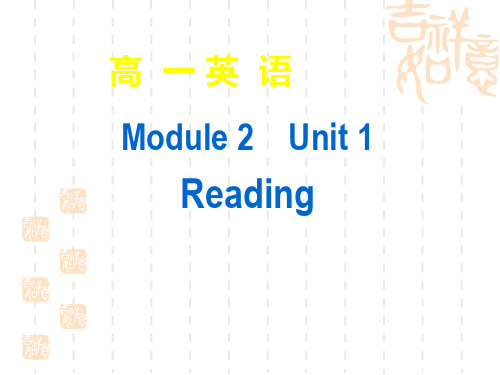
1. Finish D & E on pages 4 – 5; A1 &A2 on P86.
2. All the people are concerned about Justin’s disappearance. What do you think might have happened to him? Please give an ending to the
Justin’s friends said
_t_h_a_t_J_u_s_t_in__w_e_n_t__h_o_m_e__a_ft_e_r___ Justin _p_l_a_y_in__g_b_a_s_e_b_a_l_l_w_i_th__t_h_e_m_.___ Foster Witnesses said _th_a_t_t_h_e_y__s_a_w__ returned _J_u_s_ti_n__w_a_lk_i_n_g__to_w__a_rd__s_h_i_s____ home. _h_o_u_s_e__a_t _1_0_.4_5__p_.m__.
Fill in the table
Main Supporting details Points
Justin Mrs. Foster thought he Foster was spendindigdnt’ht eshnoiwghupt at went wJuisthtina’sffrriieenndds.said ____________ missin J__u_s_t_i_n__F_o_s__te_r______________
◎List three features (特征) of a news
title.
Attractive, exact, direct .
牛津译林版高一英语模块2Unit1reading教案
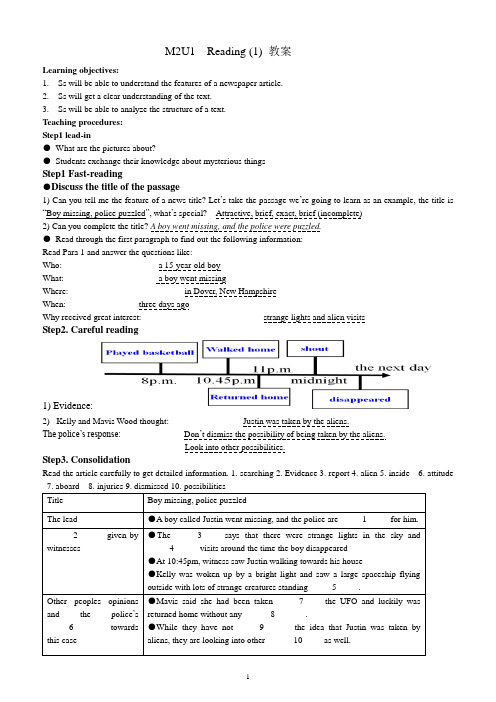
M2U1 Reading (1) 教案Learning objectives:1.Ss will be able to understand the features of a newspaper article.2.Ss will get a clear understanding of the text.3.Ss will be able to analyze the structure of a text.Teaching procedures:Step1 lead-in●What are the pictures about?●Students exchange their knowledge about mysterious thingsStep1 Fast-reading●Discuss the title of the passage1) Can you tell me the feature of a news title? Let’s take the passage we’re going to learn as an example, the title is “Boy missing, police puzzled”, what’s special? Attractive, brief, exact, brief (incomplete)2) Can you complete the title? A boy went missing, and the police were puzzled.●Read through the first paragraph to find out the following information:Read Para 1 and answer the questions like:Who: __________________ a 15-year-old boyWhat: __________________ a boy went missingWhere: ________________________ in Dover, New HampshireWhen: ______________three days agoWhy received great interest: __________________________ strange lights and alien visitsStep2. Careful reading1) Evidence:2)Kelly and Mavis Wood thought: ________________ Justin was taken by the aliens.The police’s response:______________ Don’t dismiss the possibility of being taken by the aliens._____________ Look into other possibilities.Step3. ConsolidationRead the article carefully to get detailed information. 1. searching 2. Evidence 3. report 4. alien 5. inside 6. attitude Title Boy missing, police puzzledThe lead ●A boy called Justin went missing, and the police are _____1_____ for him.______2______ given by witnesses ●The _____3____ says that there were strange lights in the sky and _____4______visits around the time the boy disappeared●At 10:45pm, witness saw Justin walking towards his house●Kelly was woken up by a bright light and saw a large spaceship flying outside with lots of strange creatures standing _____5_____.Other peoples opinions and the police’s _____6_____ towards this case ●Mavis said she had been taken _____7____ the UFO and luckily was returned home without any ______8_______.●While they have not _____9______ the idea that Justin was taken by aliens, they are looking into other ______10_____as well.Step 4. Reading strategy: The features of a newspaper articleTitle: attractive, direct, exact, briefThe lead: Main idea and the most important factsThe second part: detailed but less important informationThe last part: commentsStep 5. Consolidation exercises: Reading comprehensionA(2015 重庆)LakeLander ·2 hours agoToday, a man talked very loud on his phone on a train between Malvern and Reading, making many passengers upset. I wonder how he would react if I were to read my newspaper out loud on the train, I have never had the courage to do it, though.Pak50 ·57 minutes ago Why not give it a try? Perhaps you should take lessons on a musical instrument. The late musician Dennis Brian is said to have asked a fellow train passenger to turn off his radio. When his request was refused, he took out his French horn(号) and started to practice.Angie O’Edema ·42 minutes agoI don’t see how musical instruments can help improve manners in public. Don’t do to others what youwouldn’t like to be done to yourself. Once, a passenger next to me talked out loud on his mobile phone. I left my seat quietly, giving him some privacy to finish his conversation. He realized this and apologized to me. When his phone rang again later, he left his seat to answer it. You see, a bit of respect and cooperation can do the job better.Taodas ·29 minutes agoI did read my newspaper out loud on a train, and it turned out well. The guy took it in good part, and wechatted happily all the way to Edinburgh.Sophie 76 ·13minutes agoI have not tried reading my newspaper out loud on a train, but ,several years ago, I read some chaptersfrom Harry Porter to my bored and noisy children. Several passengers seemed to appreciate what I did.1. The passenger made an apology to Angie O’Edema because____.A. he offered his seat to someone elseB. he spoke very loudly on his phoneC. he refused to talk with AngieD. he ignored Angie’s request2. Who once read a newspaper out loud on a train?A. Pak50B. Angie O’EdemaC. TaodasD. Sophie763. What is the discussion mainly about?A. How to react to bad behavior.B. How to kill time on a train.C. How to chat with strangers.D. How to make a phone call.4. Where is the passage most probably taken from?A. A webpage.B. A newspaper.C. A novel.D. A report.1. B 细节理解题。
牛津高中英语模块二一单元全英文教案
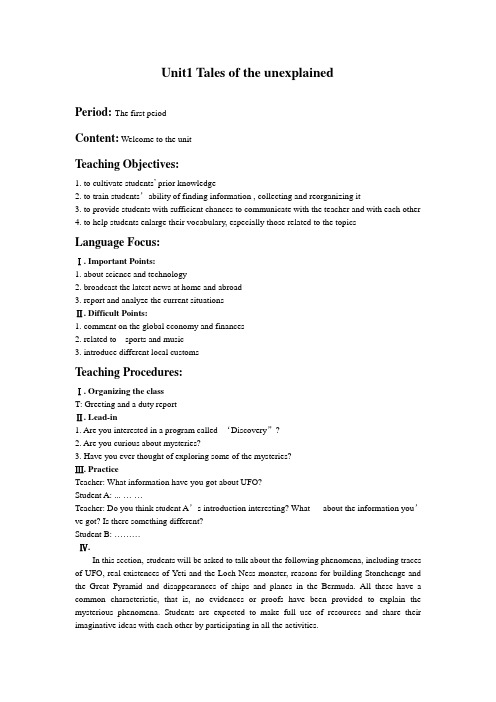
Unit1 Tales of the unexplainedPeriod: The first peiodContent: Welcome to the unitTeaching Objectives:1. to cultivate students’ prior knowledge2. to train students’ability of finding information , collecting and reorganizing it3. to provide students with sufficient chances to communicate with the teacher and with each other4. to help students enlarge their vocabulary, especially those related to the topicsLanguage Focus:Ⅰ. Important Points:1. about science and technology2. broadcast the latest news at home and abroad3. report and analyze the current situationsⅡ. Difficult Points:1. comment on the global economy and finances2. related to sports and music3. introduce different local customsTeaching Procedures:Ⅰ. Organizing the classT: Greeting and a duty reportⅡ. Lead-in1. Are you interested in a program called ‘Discovery”?2. Are you curious about mysteries?3. Have you ever thought of exploring some of the mysteries?Ⅲ. PracticeTeacher: What information have you got about UFO?Student A: ... ……Teacher: Do you think student A’s introduction interesting? What about the information you’ve got? Is there something different?Student B: ………Ⅳ.In this section,students will be asked to talk about the following phenomena, including traces of UFO, real existences of Yeti and the Loch Ness monster, reasons for building Stonehenge and the Great Pyramid and disappearances of ships and planes in the Bermuda. All these have a common characteristic, that is, no evidences or proofs have been provided to explain the mysterious phenomena. Students are expected to make full use of resources and share their imaginative ideas with each other by participating in all the activities.1 ( before taking up the task)The teacher assigns students a task, that is, all of them are required to surf the net or refer to some reference books, in English or in Chinese to get some information about UFO, Yeti, the Loch Monster, Bermuda, Stonehenge and the Great Pyramid. The activity can be conducted like this: The topics we are going to deal with in our next period are not only very interesting and attractive, but a bit mysterious as well. They are beyond our knowledge. Even the advanced science and technology of today cannot offer satisfactory answers, so I recommend if we’d like to discuss these topics, it is best for all of us to make preparations first, either by searching for information on the Internet or looking up background information in some books. Besides collecting information, you have to note down your answers. It’ll be more convenient for you to report back your answers if you do so.2 ( focusing on the pictures )a.Ask students to read the instructions and focus on the six pictures and illustrationsindividually first. The teacher can arouse their interest by asking them the following questions:Do the six pictures have something in common? What is it?(unexplained; no satisfactory answers; mysterious; no evidences…)Can scientists explain these phenomena?How do you feel about them? Are you a bit curious?b. Ask students to think of as many expressions as possible to answer the above questions, encourage them to make up sentences and report back their answers. The teacher can share the following sentences with students.They are mysterious because no satisfactory answers have been offered to explain their reasons.Though these mysteries have puzzled people for a long time, people show great interest in them.People feel puzzled due to their mysteries.c. Ask students to report back the information they have collected. As students have been required to prepare for the topics, their answers might be various. The teacher can vary the activities according to students’responses. If possible, some answers students provide can be used as prompt for a class discussion. For example:Teacher: What information have you got about UFO?Student A: ... ……Teacher: Do you think student A’s introduction interesting? What about the information you’ve got? Is there something different?Student B: ………This activity can be conducted flexibly.Sample answers1.Like any other intelligent and rationale person, I have a firm belief in UFOs. In fact, I have seen a few myself. UFO stands for Unidentified Flying Object, that is, an object, apparently moving in the sky, that we cannot identify. However, if you ask me whether I believe spacecraft carrying visitors from outer space, I would say ‘no’. I do not believe it.2. The continent of Antarctica was discovered in 1818. A map known as the 'Piri Reis' Map, a genuine document made in Constantinople in 1513, clearly shows the continent of Antarctica.How could this have been possible if Antarctica was not discovered until 300 years later? Antarctica was supposed to have been covered by ice for the last million or so years, but samples taken from sediment deep beneath Antarctica in 1949 revealed that great rivers had once flowed in Antarctica until about 6000 years ago.3. I’m always intere sted in the stories of UFOs and aliens. And I hope I will have the chance to meet one some day. If it really happens to me, I will ask questions such as ‘who or what are you?’ ‘Where are you from?’ ‘How long does it take to travel from your place to our planet?’ I will try my best to communicate with them, discovering what their life is like and why they come to the earth.d. Ask students to have a discussion about the topics by exploring some other activities. In order to conduct them more conveniently, the teacher can arrange numbers from left to right, from top to bottom first. For example:(Picture 1)Have you ever read some reports about UFO in Chinese?Are you interested in it?Is it really from another planet? What does UFO stand for?For what reasons do you think UFO visits our planet?Student: ………Teacher: UFOs are unidentified flying objects, but no one really knows what they are. The chances for seeing a UFO are greater for those people who live in small towns or in the country and are outside late at night. UFOs come in all shapes and sizes. Some are only small spots of light that move in strange patterns across the night sky. Some can be seen in the daytime are often disk- or saucer-shaped.(Picture 2)Where is Himalayas? What’s the weather like there?Yeti is reported to be half-man and half-beast, have you heard of it?Do you think some climbers’ disappearance have some connections with Yeti? Student: ………Teacher: The yeti is a humanlike monster who is supposed to live in the Himalayas, the highest mountain range in the world. Several sightings, mainly of footprints, have been reported by westerner explorers throughout the years. Yet none of them have been supported with evidence in any way.(Pictures3, 4 and 6)Stonehenge and the Great Pyramid of Egypt are both cultural relics.Where is the Great Pyramid built, on the east coast of the Nile or on the west of it? Whatare its reasons?Do you think the Great Pyramid a wonder in the human history? How was the GreatPyramid built?I haven’t heard of Stonehenge or the Ness Monster. They are a bit new to me. What aboutyou? Will you be interested in making discoveries about them when you grow up? Student: ………Teacher: On the 21st December 1933, the Daily Mail carried the following headline: "Monster of Loch Ness is not a Legend but a Fact." The hunter, M A Wetherall, a member of the Royal Geographical Society and the London Zoological Society said: "It is a four fingered beast and it has feet or pads of eight inches across. I judge it to be a powerful soft footed animal about 20 feet in length....... I am sure that it can breathe like a crocodile with just one nostril out of the water." Not much is known about Khufu. The tomb had been robbed long before archeologists came upon it. Any information about Khufu was taken with the objects inside the tomb. He is thought to have been the ruler of a highly structured society and he must have been very wealthy. He was buried alone in this massive tomb. His wives may have been buried nearby in smaller mastabas.(Picture 5)While talking about picture 4, the teacher can show a map to the students and point tothem clearly where Florida and the Bermuda Florida are on the map.Are there any monsters in these areas?Why do ships or planes disappear in this area?Do you think it is too mysterious?Suppose there is a ship equipped with the latest scientific equipment and it can make contact with scientists on land at any time, do you think it will be possible to solve the mysteries?Ⅴ. Exercise in class1. Scientists are convinced _____ the positive effect of laughter _____ physical and mental health.A. of; atB. by; inC. of; onD. on; at2. Kathy ______ some French while she was away on a business trip in France.A. picked upB. took upC. made upD. turned up3. The _______ boy made the police and his family _______.A. gone; puzzledB. missing; puzzledC. missing; puzzlingD. lost; puzzling4. Liu Xiang is believed _________ over $ 20 million in advertisements last year alone.A. to earnB. have earnedC. to have earnedD. having earned5. __________ your help, I passed the examination without any difficulty.A. Because ofB. Owing toC. Due toD. Thanks to6. Finally she ___________ that Tom was guilty.A. was convinced ofB. was convincedC. convincedD. was convincing7. Every time he returned from work, Paul would _________ his favorite music to relax himself.A. put onB. take onC. get onD. set on8. Our teacher told us that she was rather __________ at the __________ result of the test.A. disappointed; disappointingB. disappointing; disappointedC. disappointing; disappointingD. disappointed; disappointed9. The research group ____________ 15 members has made great achievements in recent years.A. is made up ofB. makes upC. made up ofD. making up of10. While our manager is away on business, our company will be _____________ Mr. Zhang.A. in the charge ofB. in charge ofC. taken charge ofD. taking the charge ofAnswer:1-5 CABCD 6-10 BAACAⅦ. Homework1 Pair students up first. Let different pairs focus on different questions. If possible, the first question can be adapted easily like this:Do you believe in UFOs? What may be the explanations of UFOs?——Aliens from space without a doubt——Military test craft without a doubt——Some UFOs are alien, some are test craft——UFOs are evidence of human space travel——UFOs are neither alien nor test craft——UFOs don't existEncourage students to express their agreements or disagreements about it.2 Ask different pairs to summarize their answers and then report them back.。
高中英语 Book 2U1Reading课件 牛津必修2
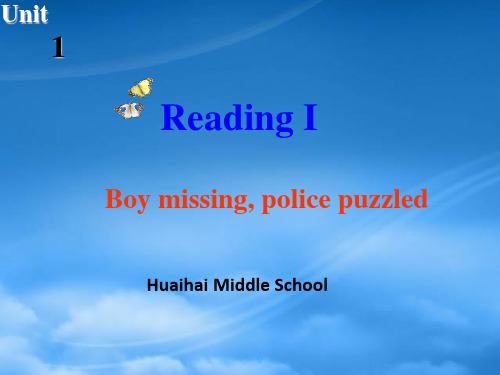
Fast Reading
Boy missing, police puzzled It’s about __________ the first paragraph: when____________; where____________________; who__________; what___________; how_________________; why_______________________ _______________ the following paragraphs: evidence given by____________________________
Part 1 Revision
Revision
Task 1:Revise what we learnt in last period Task 2:Tell us to report what we learnt in last unit.
Lead-in
(Agencies)Large Medium Small GELSENKIRCHEN, Germany - Spanish striker Raul scored twice to help steer Schalke 04 to a 3-1 win over Israel's Hapoel Tel Aviv in their Champions League Group B encounter on Wednesday. Schalke 04's Raul celebrates a goal against Hapoel Tel Aviv during their Champions League soccer match in Gelsenkirchen October 20, 2010. [Photo/Agencies] Raul, the competition's all-time top goal scorer, struck after only three minutes, combining well with Klaas-Jan Huntelaar, before adding his 68th Champions League goal from close range early in the second half
高中英语 M2 U1 reading课件 牛津版必修2

boy’s disappearance. B. the police haven’t found convincing
evidence about the boy’s disappearance C. the police will catch the aliens who took
to do with the UFO and the alien. D. All of the above
Task 3 Choose the best answer
2. In the second paragraph, “show up” means _________.
A. arrive or appear B. Reach C. Disappear D. reach for
Title:
Paragraph1-2:
who what when where why how
Task 1 Main points
Title: Boy missing, police puzzled
to give a general idea about the news
Task 1 Main points
At 8 p.m. last Friday Justin left home to play baseball with two friends.
The course of the event
Witnesses say they saw Justin 2)______ towards his home at 10.45 p.m.
Homework
- 1、下载文档前请自行甄别文档内容的完整性,平台不提供额外的编辑、内容补充、找答案等附加服务。
- 2、"仅部分预览"的文档,不可在线预览部分如存在完整性等问题,可反馈申请退款(可完整预览的文档不适用该条件!)。
- 3、如文档侵犯您的权益,请联系客服反馈,我们会尽快为您处理(人工客服工作时间:9:00-18:30)。
译林牛津英语模块二第一单元reading部分完整说课稿Good morning, dear professors. My name is Zhang Qingqing, a postgraduate student in Nanjing normal university. It’s my great honor to have the chance to share my understanding about how to teach reading. According to the New Curriculum Standards, reading is an important section where ss can contact English language and cultural knowledge on the largest scale and improve their ability to solve problems in daily life. So in the reading process, I will focus on students’ long-term development and help them use proper reading skills and strategies. In other words, ss are guided to read efficiently and independently. Next I will briefly introduce my lesson from seven parts, they are analysis of the teaching material, target students, teaching aims and learning objectives, teaching focus and learning difficulties, teaching and learning methods, teaching procedures and blackboard design.The first part is my analysis of the teaching material. The selected material is “the boy missing, police puzzled” taken from the reading section of Module2 Unit 1 of Advance with English for senior school ss. The article is a newspaper article about a boy called Justin Foster is missing and people wonder if he is taken away by UFO. After reading this article, ss cannot only improve their language competence and acquire more cultural knowledge, but also can become more confident and advance their personalities. That is they can develop their Integrated Language Capability which is the core of the New Curriculum Standards.Then is my analysis of target ss. For senior high school ss, they have learned English for several years and have acquired some basis knowledge of English. Their cognitive schema and abstract thinking will be developing alot in their age, which enables them to learn English more systematically and develop their Integrated Language Capability.Based on my analysis of the teaching material and target ss, I set the following teaching aims and learning objectives: By the end of the lesson, ss will be able to grasp the key words, such as …; catch the main idea of the article and have a better understanding of it; learn how to read a newspaper article; enhance their fast reading skills and word guessing skills; discuss their own experience related to the topic; advance their cooperative spirits and their spirit of exploration; build their confidence in learning. The establishment of these teaching aims and learning objectives includes ss’ cognition, skills and emotion which are to develop their Integrated Language Capability.According to teaching aims and learning objectives, I decided the teaching focus and learning difficulties as follows: help ss improve their reading abilities through classroom activities, and learn how to read a newspaper article, encourage ss to express their own experience.Then I want to introduce teaching methods, learning methods and teaching aids. I chose following teaching methods; task-based approach to help ss learn from dong to get and analyze information and solve problems; situational approach to enable ss learn English in specific context; communicative approach to develop their communicative skills and cooperative spirit; my teaching will follow three-stage model to present a clear teaching process. I strongly believe that with the help of these teaching methods, ss will learn how to construct their own knowledge and develop their autonomous & inquiry-based learning method. Besides, I chose PPT and blackboard as my teaching aids to give clear instruction and consolidate new knowledge.Next is my teaching procedure and I divided this lesson into 4 steps.The 1st Step is Pre-Reading always known as warm-up. 1st I’ll show a video about UFO; then show more pictures, photos about other unexplained things through PPT. Ask ss “what can you see in these pictures? Do you believe in them? What other unexplained things do you know about?”they are encouraged to express their own opinion on these Qs. ///2nd I will introduce the title of this lesson. Let ss predict the content but don’t give answer to develop their prediction ability.///3rd I will List some key words on the blackboard. I’ll choose those that will hinder ss’ comprehension and can not be easy to guess their meanings in the context. Ss will not feel so hard in reading comprehension.Purpose of this step: This step is to present background information of the text and solve some possible vocabulary problems, which aims to stimulate ss’ existing knowledge, activate their cognitive schema and arouse their interests. It enables ss to make preparation for the following reading.The 2nd Step is While-Reading. I prepare 4 tasks. The 1st task: ask ss to go through the passage as quickly as possible and find answers to Qs in part A. Purpose is to develop ss’ fast-reading skills-skimming & scanning and get the general idea about the article. I’ll ask ss to check in pairs to develop their peer assessment ability. ///The 2nd task: I’ll let ss reread and finish exercises C1C2 individually. C1 is to check ss’ ability to read and locate specific information. C2 serves as a strengthening activity for ss’comprehension. After they finished, I’ll conduct a feedback activity. ///The 3rd task: I’ll Let Ss reread the article. I’ll provide a chart for them to fill in through PPT to check ss’comprehension. Let ss work in pairs to develop their collaboration and build their confidence. I’ll give feedback. The chart can also be used to analyze and highlight the mainstructural organization of the text/part of the text, which shows ss how the structure relates to meaning. Purpose: ss can have a clear understanding of the article as a whole and comprehend it in the discourse level, which is easier for them to understand the reading strategies.///The 4th task: ask ss to complete D & F individually and then check the answers as a class. Part D is to develop ss’ comprehension of words from the context and match them with the correct definitions. Part E is a specific situation which requires ss first understand it and fill in blanks with proper words.The 3rd Step is Post-Reading. I will introduce some more words related to the topic to enlarge their vocabulary and are also helpful for the following discussion. For example,…Then I set a situation for ss to discuss that is “what do you opinion about this article? Do you believe that the boy is taken by UFO? Why or why not? Can you think about some other possible reason related to our daily life? ” I will ask ss first discuss these questions in group of four and share their opinions in the class. This task is employed to build ss’language communicative competence and ss can relate to their daily life. It can strengthen their comprehension and develop their imagination. Since these Qs are interesting for ss to discuss, they will be active and more confident in expressing their opinions.The 4th Step is summary and homework. Make a summery about what ss have learned in this lesson and check ss as a whole with the help of the blackboard and PPT. And I’ll leave ss some time to ask Qs and give in-time feedback. Ask ss to do parts A1A2 in workbook and find more information about unexplained things through internet or magazines and share them in the next class. Homework is arranged to consolidate what they have learned and develop ss’ learning abilities after class such as automatic learning.The last section is my blackboard design. A good blackboard design is just like a tiny teaching plan. My purpose in using blackboard is to clearly transfer the essence of the lesson to ss in order to help them grasp the main points they have learned in this lesson. So I designed it as follows: By now, I have explained my teaching plan from analysis of teaching material, target ss, teaching aims and learning objectives, teaching focus and learning difficulties, teaching and learning methods, teaching procedures and blackboard design. And I hope my ss will enjoy the whole class. That’s all, thank you for your attention.。
